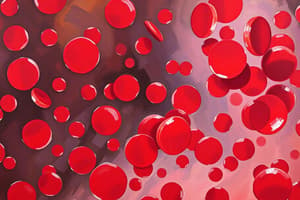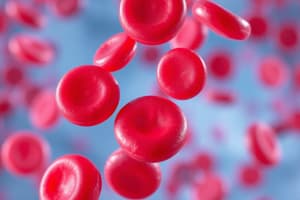Podcast
Questions and Answers
Which disorder is characterized by a deficiency in the glycoprotein complex Gplb-IX-V?
Which disorder is characterized by a deficiency in the glycoprotein complex Gplb-IX-V?
- Immune thrombocytopenia
- Glanzmann thrombasthenia
- Uremic platelet dysfunction
- Bernard-Soulier syndrome (correct)
What is the main cause of Immune thrombocytopenia?
What is the main cause of Immune thrombocytopenia?
- Increased platelet aggregation
- Destruction of platelets by spleen macrophages (correct)
- Accumulation of uremic toxins
- Deficiency in Gplb-IX-V
Which disorder does NOT have a noted platelet count in the table?
Which disorder does NOT have a noted platelet count in the table?
- Uremic platelet dysfunction
- Bernard-Soulier syndrome
- Glanzmann thrombasthenia (correct)
- Immune thrombocytopenia
The deficiency of which complex is associated with decreased platelet-to-platelet binding in Glanzmann thrombasthenia?
The deficiency of which complex is associated with decreased platelet-to-platelet binding in Glanzmann thrombasthenia?
What treatment is mentioned for refractory Immune thrombocytopenia?
What treatment is mentioned for refractory Immune thrombocytopenia?
What is a defined characteristic of uremic platelet dysfunction?
What is a defined characteristic of uremic platelet dysfunction?
What is a common feature of Bernard-Soulier syndrome and Immune thrombocytopenia?
What is a common feature of Bernard-Soulier syndrome and Immune thrombocytopenia?
Which of the following laboratory findings is associated with Immune thrombocytopenia?
Which of the following laboratory findings is associated with Immune thrombocytopenia?
Which disorder is characterized by a deficiency in glycoprotein complex Gplb-IX-V?
Which disorder is characterized by a deficiency in glycoprotein complex Gplb-IX-V?
What is the primary cause of Immune thrombocytopenia?
What is the primary cause of Immune thrombocytopenia?
In which disorder is platelet aggregation primarily affected?
In which disorder is platelet aggregation primarily affected?
Which laboratory finding is associated with Immune thrombocytopenia?
Which laboratory finding is associated with Immune thrombocytopenia?
What effect do uremic toxins have on platelets?
What effect do uremic toxins have on platelets?
What is a treatment option for refractory Immune thrombocytopenia?
What is a treatment option for refractory Immune thrombocytopenia?
Which disorder is characterized by increased bleeding time and decreased platelet count?
Which disorder is characterized by increased bleeding time and decreased platelet count?
Which characteristic is noted in the blood smear for a patient with Glanzmann thrombasthenia?
Which characteristic is noted in the blood smear for a patient with Glanzmann thrombasthenia?
What is a characteristic defect of Bernard-Soulier syndrome?
What is a characteristic defect of Bernard-Soulier syndrome?
Which disorder is primarily associated with increased bone marrow megakaryocytes?
Which disorder is primarily associated with increased bone marrow megakaryocytes?
What is the primary action that is impaired in Glanzmann thrombasthenia?
What is the primary action that is impaired in Glanzmann thrombasthenia?
Uremic platelet dysfunction primarily affects which of the following?
Uremic platelet dysfunction primarily affects which of the following?
Which treatment option is commonly used for refractory immune thrombocytopenia?
Which treatment option is commonly used for refractory immune thrombocytopenia?
What differentiates immune thrombocytopenia from Bernard-Soulier syndrome and Glanzmann thrombasthenia?
What differentiates immune thrombocytopenia from Bernard-Soulier syndrome and Glanzmann thrombasthenia?
In which condition is a blood smear likely to show no platelet clumping?
In which condition is a blood smear likely to show no platelet clumping?
What is the main cause of increased bleeding time in patients with uremic platelet dysfunction?
What is the main cause of increased bleeding time in patients with uremic platelet dysfunction?
Flashcards are hidden until you start studying
Study Notes
Platelet Disorders Overview
- Various disorders lead to altered bleeding times and platelet counts, affecting hemostasis.
- Disorders are characterized by specific defects in platelet function or quantity.
Bernard-Soulier Syndrome
- Increased bleeding time with decreased platelet count.
- Autosomal recessive disorder resulting from a deficiency in the glycoprotein complex Gplb-IX-V.
- Impaired binding of platelets to von Willebrand factor (vWF), essential for adhesion to damaged blood vessels.
- Laboratory findings show decreased platelet aggregation.
Glanzmann Thrombasthenia
- Increased bleeding time with normal platelet count.
- Autosomal recessive disorder linked to a deficiency in GplIb/IIIa (integrin αIIbβ3).
- Leads to decreased platelet-to-platelet aggregation, impacting platelet plug formation.
- Blood smear reveals no platelet clumping, indicating defective aggregation.
Immune Thrombocytopenia (ITP)
- Increased bleeding time with decreased platelet count.
- Autoimmune disorder marked by the destruction of platelets, primarily in the spleen.
- Mediated by antibodies against GpIIb/IIIa resulting in splenic macrophage-mediated destruction.
- Causes include idiopathic origins, secondary autoimmune disorders (e.g., SLE), viral infections (e.g., HIV, HCV), malignancies (e.g., CLL), and drug reactions.
- Bone marrow analysis shows increased megakaryocytes; CBC confirms decreased platelet count.
- Treatment options include glucocorticoids, IVIG, rituximab, TPO receptor agonists (e.g., eltrombopag, romiplostim), and splenectomy for refractory cases.
Uremic Platelet Dysfunction
- Increased bleeding time with normal platelet count.
- Normal platelet function is compromised due to the accumulation of uremic toxins in cases of renal failure.
- Uremic toxins hinder adhesion and aggregation, increasing bleeding risk.
Platelet Disorders Overview
- Disorders characterized by abnormalities in platelet function and number can significantly impact bleeding time and are crucial for diagnosis and treatment.
Bernard-Soulier Syndrome
- Autosome recessive disorder leading to increased bleeding time and decreased platelet count.
- Defect in adhesion due to deficiency of glycoprotein complex Gplb-IX-V affecting platelet-to-von Willebrand factor binding.
- Impaired adhesion results in defective platelet aggregation.
- Laboratory findings include decreased platelet aggregation.
Glanzmann Thrombasthenia
- An autosomal recessive disorder with increased bleeding time but normal platelet count.
- Deficiency in GplIb/Illa (integrin αIIbβ3) leads to decreased aggregation and defective platelet plug formation.
- Blood clotting is hindered due to absence of platelet clumping, evident on blood smear analysis.
Immune Thrombocytopenia
- Autoimmune disorder marked by increased bleeding time and a decreased platelet count.
- Characterized by destruction of platelets mediated by anti-GpIIb/IIIa antibodies targeting platelets for splenic macrophage destruction.
- Common causes include idiopathic factors, other autoimmune diseases, viral infections (HIV, HCV), malignancies (e.g., CLL), and drug reactions.
- Laboratory analysis reveals increased megakaryocytes in bone marrow and decreased platelet count in CBC.
- Treatment options include glucocorticoids, IVIG, rituximab, TPO receptor agonists (like eltrombopag and romiplostim), and splenectomy for severe cases.
Uremic Platelet Dysfunction
- Impaired platelet function leads to increased bleeding time due to accumulation of uremic toxins.
- Uremic toxins disrupt platelet adhesion and aggregation, increasing the risk of bleeding, especially in patients with renal failure.
- Normal platelet function is compromised, making effective clotting challenging.
Platelet Disorders Overview
- Platelet disorders affect the ability of blood to clot, leading to an increased risk of bleeding.
- Testing typically involves measuring bleeding time (BT) and platelet count (PC).
Bernard-Soulier Syndrome
- Characterized by increased bleeding time and decreased platelet count.
- An autosomal recessive disorder caused by a deficiency in the glycoprotein complex GpIb-IX-V.
- Leads to decreased binding of platelets to von Willebrand factor (vWF), essential for adhesion at injury sites.
- Laboratory findings include decreased platelet aggregation.
Glanzmann Thrombasthenia
- Increased bleeding time noted; platelet count normal.
- An autosomal recessive disorder due to a deficiency in GpIIb/IIIa (integrin αIIbβ3).
- Causes impaired platelet aggregation, affecting the formation of platelet plugs.
- Blood smears show no clumping of platelets.
Immune Thrombocytopenia (ITP)
- Features increased bleeding time and decreased platelet count.
- An autoimmune disorder where anti-GpIIb/IIIa antibodies lead to platelet destruction in the spleen.
- Causes include idiopathic origins, secondary to autoimmune disorders (like SLE), viral infections (HIV, HCV), malignancies (e.g., CLL), and drug reactions.
- Laboratory analysis reveals increased megakaryocytes in bone marrow and decreased platelets in CBC.
- Treatment options include glucocorticoids, IVIG, Rituximab, TPO receptor agonists (e.g., eltrombopag, romiplostim), and splenectomy for cases that are refractory.
Uremic Platelet Dysfunction
- Increased bleeding time due to impaired platelet function, not a reduction in count.
- Caused by the accumulation of uremic toxins, particularly in patients with renal failure.
- Uremic toxins disrupt platelet adhesion and aggregation, raising bleeding risk.
Studying That Suits You
Use AI to generate personalized quizzes and flashcards to suit your learning preferences.




